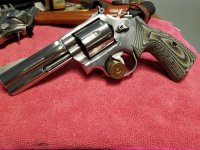I haven't yet received my Python, so maybe things will change, but...
My 1955 .357 magnum was delivered yesterday, I had it passed by a gunsmith this afternoon, I cleaned and lubed it shortly thereafter, I fired about 100 rounds of 357 158 grain through it an hour later, and I'm in love. To be fair, I gave my 686+ 14 rounds first. But there was something about the .357 magnum (I know it's correct, but it seems ambiguous to call it that?) that was just incredible. I immediately thought that a previous owner had done something special to the trigger, but maybe all pre-27's and '27's have that same special feeling? I'm truly a .357 newbie, so I'll lean on ignorance. Since I'm 60, hopefully you all will forgive me. How many of us get to go back to the excitement of youth at 60?
I had put a 1984 target grip on the 686 earlier, and it was too big for my hands, so I went back to the factory rubber grips. The pre-27 came with similar late 1950's target grips which I immediately replaced with period dark walnut service diamond magna grips. They look great but are too small. I'm starting to feel like Goldilocks. Even with my right palm wrapping around the bottom of the service grips, it was still a great experience. I planned on shooting two cylinders worth, but ended up shooting a box of Fiocchi and a box of Black Hills, then two cylinders of PMC 38 special. The 38's were like throwing darts (if you are good at that). It felt like shooting my old Ruger single-six 22.
I'm a very happy guy right now. I can't imagine what introducing the Python into the equation will do, but that should happen this Friday. Honestly, as happy as I was with the Python deal, I would give it back right now - there just isn't any need for a Python. But listen to me Friday and I'll look like a flip-flopping moron.
edited to add: By the way, L vs N frame didn't matter much, but the thickness of the forcing cone was hugely larger in the N-frame. I would guess the larger N-frame was part of why I liked the .357 magnum so much.



